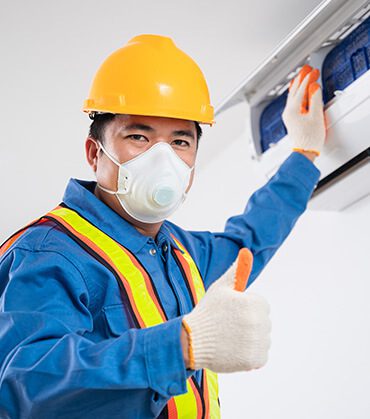In the last two decades, Americans have experienced more temperature variation than at anytime in history. Our summers are becoming hotter and our winters colder. As a result, we have become even more dependent on our HVAC air conditioning systems.
Many Americans rely on HVAC air conditioning systems to stay comfortable and maintain a healthy indoor environment. HVAC air conditioning systems have several essential components, one of the most important being the thermostat.
What Is a Thermostat
The thermostat is a monitoring device that senses and regulates the air temperature of a particular environment. Thermostats are a critical component in refrigeration units, car cooling systems, and heating and cooling HVAC air conditioning systems.
A thermostat is a programmable device that monitors the ambient temperature in a particular environment and initiates a process should the temperature fall below or rise above the pre-programmed temperature.
For example, when the room temperature falls below the pre-programmed temperature, the thermostat will generate electrical signals instructing the boiler to operate and create warm air. The thermostat works the same way when cooling. When the temperature in a room rises above a preset level, the thermostat senses it and sends electrical signals telling the HVAC air conditioning system to produce cold air.
When the thermostat records a temperature within the desired range, it signals the HVAC system to stop the heating or cooling process. The thermostat helps maintain a constant room temperature, an essential element of an expected level of comfort.
How Do Thermostats Work
The thermostat works on a process called thermal expansion. The thermostat contains two metal strips bolted together, each composed of a different metal (steel and copper, or steel and brass) that expand and contract according to how hot or cold they get.
The strips are called bimetallic strips, and as they expand and contract, they form a bridge within the electrical circuit that signals the HVAC system to produce cool or hot air. The expansion and contraction will switch on and turn off an electrical circuit that controls the heating and cooling process.
The History of Thermostats
The first thermostat appeared in a rudimentary form in 1620. Cornelius Drebbel invented an oven that incorporated a mercury thermostat and an air intake that expands and contracts, allowing more or less hot air into the oven.
In 1830, a Scotsman named Andrew Ure invented a thermostat to keep steam boilers warm. Also, in 1830, Warren Johnson invented an electrical thermostat that helped keep his classrooms warm.
In 1883, Albert Butz patented the damper flapper that controls the airflow into coal furnaces, lowering or raising the temperature, and in 1906 Mark Honeywell used Butz’s patent as the basis for the first programmable thermostat.
In 1934, the thermostat containing an electric clock first appeared. In the 1950s, the first dial thermostats began to appear, and similar thermostats are still operating today.
The 1980s saw the first digital display thermostats become available, and in the late 1990s and early 2000s, a new generation of smart thermostats connected to the internet began to appear.
What Are the Different Types of Thermostats
When defining the different types of thermostats, the definitions are usually based on whether the thermostat contains mechanical or digital components. The mechanical thermostat uses physical mechanisms to measure and control the air temperature, whereas the digital thermostat uses electrical sensors.
For example, the mechanical thermostat will utilize bimetallic strips, gas-filled bulbs, and air tubes. The digital thermostat uses electrical sensors to detect variations in temperature, and digital thermostats are programmable and don’t need manual operation.
The different types of thermostats can also be categorized using voltage as the determining factor. For example, there are line voltage thermostats and low voltage thermostats. A line voltage thermostat has an electrical voltage that flows through the thermostat into the heater and is usually used in single heating systems. Line voltage thermostats operate on 240 volts.
Low voltage thermostats are usually incorporated into central heating and HVAC systems. Low voltage systems are more adaptable and enable easier program control. Line voltage thermostats operate on 24 volts to 50 volts.
What Is a Water Heater Thermostat
Thermostats can also be categorized by the device and the function they serve. One example of this is the water heater thermostat. It is a temperature-activated device that monitors and controls the water temperature.
The water heater thermostat regulates the water temperature by switching the upper and lower elements on and off. It senses the water temperature and energizes the element to heat the water when it reaches below a pre-programmed temperature. All modern water heater thermostats are programmable.
Central Heating Thermostat
Another example of a thermostat defined by its function is the central heating thermostat. It heats an entire building from one central source. The central heating thermostat monitors a building’s ambient temperature and instructs the heating or cooling system to make adjustments once the ambient temperature rises above or falls below a pre-programmed temperature.
Key Takeaway
A thermostat is an essential part of any HVAC air conditioning, cooling and heating system. It monitors ambient room temperature, and when that temperature dips below or rises above a pre-programmed temperature, the thermostat will instruct the HVAC system to make appropriate cooling or heating changes.
Thermostats are subject to wear and tear and can malfunction. If you experience problems with your thermostat, contact our experts at DunRite Heating & Air, Inc. We have the necessary skills, experience, and equipment to repair your thermostat.
For thermostat repairs, contact DunRite Heating & Air, Inc.
If you are experiencing discomfort because your HVAC in San Jose is not working efficiently, the problem could be the thermostat. For a professional checkup of your thermostat or if your thermostat requires maintenance, contact DunRite Heating & Air Inc. We can conduct a maintenance check, make the necessary repairs, and ensure your thermostat is operating at peak efficiency.



